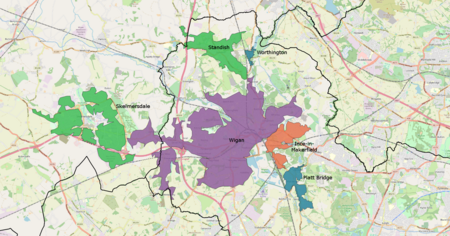Wigan urban area
Geography of LancashireGeography of the Metropolitan Borough of WiganUrban areas of England

The Wigan Urban Area is an area of land defined by the Office for National Statistics consisting of the built-up, or 'urbanised' area containing Wigan in Greater Manchester and Skelmersdale in West Lancashire. The Urban Area includes the integrated conurbation around Wigan, (containing the contiguous areas of Ince-in-Makerfield and Wigan itself), along with the outlying areas of Standish, Abram and the West Lancashire town of Skelmersdale. The Wigan Urban Area has a total population of 175,405. This is an increase of 5% on the 2001 figure of 166,840.
Excerpt from the Wikipedia article Wigan urban area (License: CC BY-SA 3.0, Authors, Images).Wigan urban area
King Street,
Geographical coordinates (GPS) Address Nearby Places Show on map
Geographical coordinates (GPS)
| Latitude | Longitude |
|---|---|
| N 53.544 ° | E -2.631 ° |
Address
King Street 29-33
WN1 1DY , Wallgate
England, United Kingdom
Open on Google Maps







